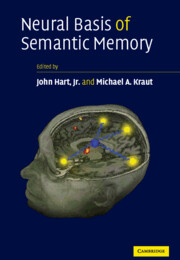Book contents
- Frontmatter
- Contents
- List of contributors
- Preface
- Part I Semantic Memory: Building Models from Lesions
- Part II Insights from Electrophysiology
- Part III Applications of Models to Understanding Cognitive Dysfunction
- Part IV Representations of Nouns and Verbs vs. Objects and Actions
- Part V Critical Role of Subcortical Nuclei in Semantic Functions
- Part VI Conceptual Models of Semantics
- Part 10 Process and content in semantic memory
- 11 The conceptual structure account: A cognitive model of semantic memory and its neural instantiation
- 12 Neural foundations for conceptual representations: Evidence from functional brain imaging
- 13 Neural hybrid model of semantic object memory (version 1.1)
- Index
- References
11 - The conceptual structure account: A cognitive model of semantic memory and its neural instantiation
from Part VI - Conceptual Models of Semantics
Published online by Cambridge University Press: 14 September 2009
- Frontmatter
- Contents
- List of contributors
- Preface
- Part I Semantic Memory: Building Models from Lesions
- Part II Insights from Electrophysiology
- Part III Applications of Models to Understanding Cognitive Dysfunction
- Part IV Representations of Nouns and Verbs vs. Objects and Actions
- Part V Critical Role of Subcortical Nuclei in Semantic Functions
- Part VI Conceptual Models of Semantics
- Part 10 Process and content in semantic memory
- 11 The conceptual structure account: A cognitive model of semantic memory and its neural instantiation
- 12 Neural foundations for conceptual representations: Evidence from functional brain imaging
- 13 Neural hybrid model of semantic object memory (version 1.1)
- Index
- References
Summary
The work described in this chapter is motivated by the conviction that a cognitive theory of semantic memory is best suited to investigate the functional and neural bases of the semantic memory system. The advantage of this approach is that detailed hypotheses about the structure and function of the semantic system can be formulated and then tested in behavioral experiments with healthy individuals and neurologically impaired patients. The challenge is then to identify the neural correlates of these experimentally validated cognitive structures and processes, i.e. their neural substrates and mechanisms. The cognitive model provides a detailed framework for this investigation which, when combined with the appropriate functional–neuroanatomical technique, provides the potential to meet this challenge.
The first part of this chapter describes the Conceptual Structure Account (CSA), a cognitive model developed at the Centre for Speech, Language and the Brain. We will present the results of neuropsychological studies with patients and healthy volunteers that have tested the main claims of this model. The CSA has been the driving force in the generation of hypotheses on the neural organization of semantic memory. In the second part of this chapter, we will describe our attempts to investigate the neural instantiation of the CSA using functional imaging techniques. In particular, we will concentrate on our recent research efforts which have combined the hypotheses of the CSA with those of a hierarchical model of object processing in the ventral temporal lobe, developed in nonhuman primates, to guide the fine-grained testing of neural systems involved in semantic memory of objects (Bright et al., 2005; Moss et al., 2005; Tyler et al., 2004).
Keywords
Information
- Type
- Chapter
- Information
- Neural Basis of Semantic Memory , pp. 265 - 301Publisher: Cambridge University PressPrint publication year: 2007
References
Accessibility standard: Unknown
Why this information is here
This section outlines the accessibility features of this content - including support for screen readers, full keyboard navigation and high-contrast display options. This may not be relevant for you.Accessibility Information
- 39
- Cited by
